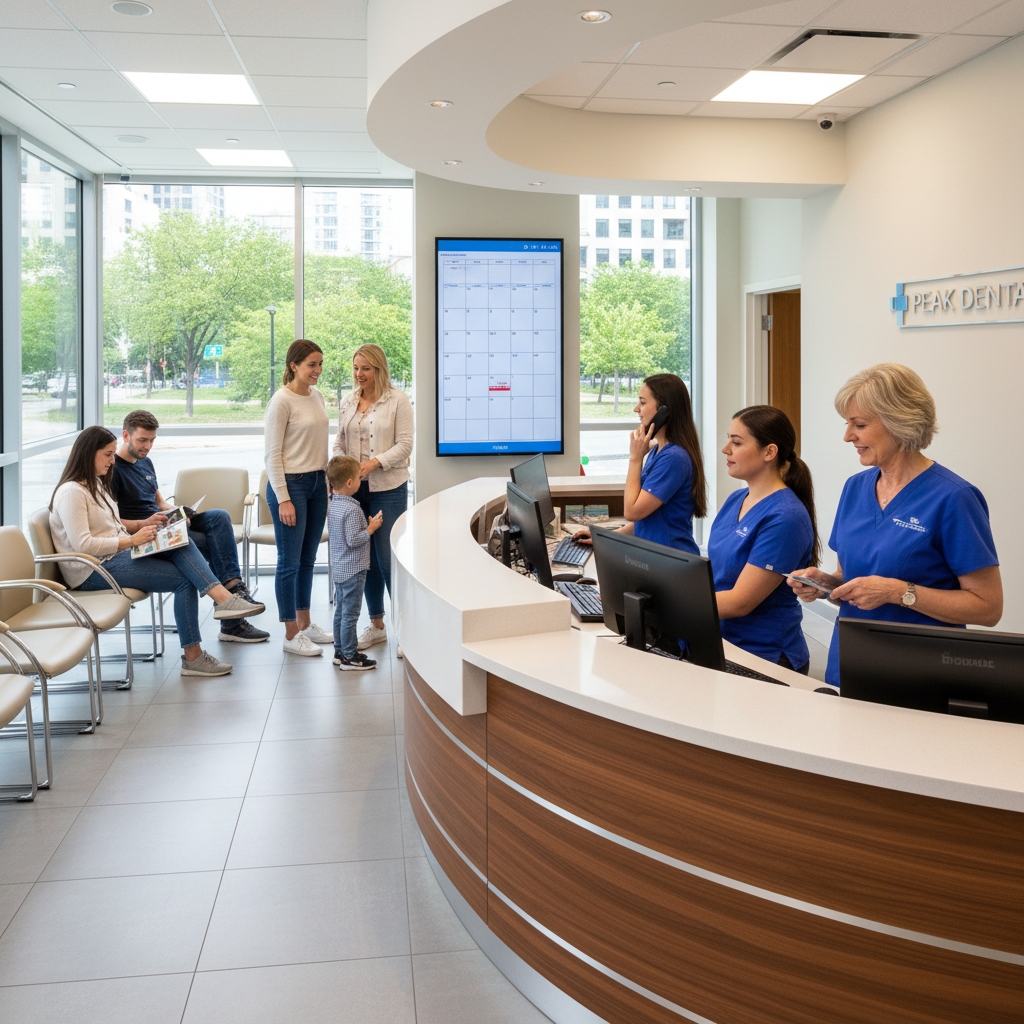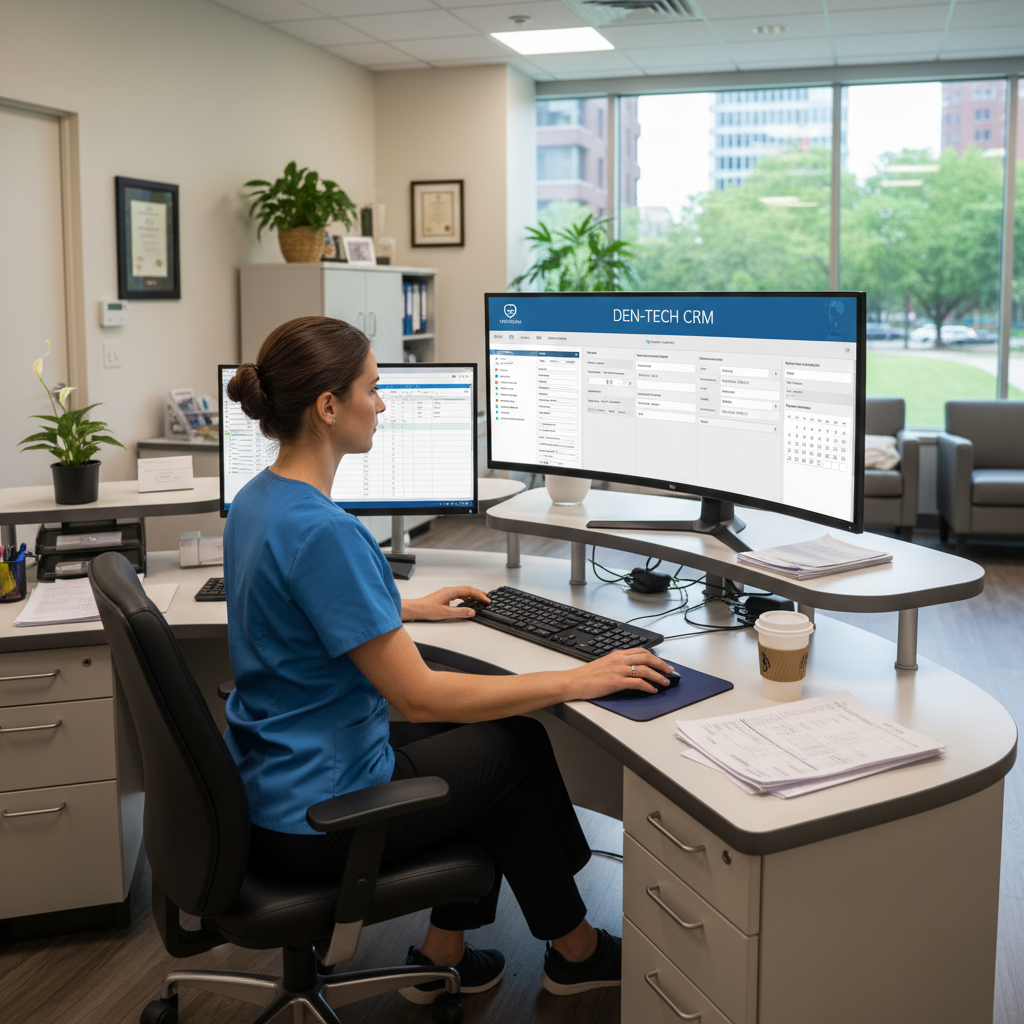












Blog Article


AI Receptionists 2024-2025: 50+ Statistics
Primary AI Receptionist Adoption Trends
- Virtual receptionist market reaches $3.85 billion in 2024, projected to hit $9 billion by 2033. This represents a compound annual growth rate of 9.8%, demonstrating the rapid mainstream adoption of AI receptionist technology. The 134% growth over nine years reflects businesses' urgent need for cost-effective customer service solutions that can scale without proportional staffing increases. Market expansion is driven by technological improvements in natural language processing and the proven ROI these systems deliver across industries. Business Research Insights projects this growth will accelerate as small and medium businesses increasingly adopt these solutions.
- AI agents market explodes from $5.4 billion to $50.31 billion between 2024-2030. This extraordinary 832% growth at a CAGR of 45.8% indicates AI receptionists are becoming fundamental business infrastructure rather than optional technology. The acceleration reflects improvements in conversational AI capabilities, particularly with GPT-4 and Claude models enabling more sophisticated customer interactions. Investment patterns suggest companies view AI agents as strategic differentiators rather than cost-cutting tools alone. Grand View Research attributes this growth to cross-industry adoption and expanding use cases beyond basic call handling.
- 78% of organizations actively use AI in at least one business function in 2024. This marks a significant jump from 55% in 2023, representing a 42% year-over-year increase that signals AI's transition from experimental to operational status. Companies are moving beyond pilot programs to full-scale deployments, with customer service leading adoption rates. The rapid acceleration suggests organizations that haven't adopted AI risk competitive disadvantage. McKinsey's Global Survey reveals that early adopters are already seeing measurable improvements in customer satisfaction and operational efficiency.
- 71% of organizations regularly use generative AI for business functions. This represents a 9% increase in just six months from early 2024, indicating unprecedented adoption velocity for enterprise technology. Generative AI's ability to handle complex, context-aware conversations makes it ideal for receptionist applications requiring nuanced communication. The technology enables AI receptionists to generate personalized responses rather than relying on scripted interactions. Organizations report that generative AI significantly improves customer experience compared to traditional chatbot systems.
- By 2025, 85% of customer interactions will be managed without human agents. This fundamental shift in customer service delivery means AI receptionists will become the primary interface for business communications within the next year. The transition reflects both technological capabilities reaching human parity and customer acceptance of AI interactions. Businesses must prepare for this reality by implementing robust AI systems that can handle complex queries while maintaining service quality. MyAI Front Desk analysis suggests companies delaying adoption risk losing customers to more technologically advanced competitors.
- Only 26% of companies successfully scale AI beyond proofs of concept. While adoption rates are high, this statistic reveals a critical implementation gap where 74% of organizations struggle to generate tangible value from AI investments. The challenge lies not in technology acquisition but in organizational change management and process integration. Successful companies invest twice as much in workforce enablement as their struggling counterparts. Boston Consulting Group's study emphasizes that AI receptionist success requires comprehensive training programs and gradual deployment strategies.
- Gartner predicts 80% of customer service organizations will use generative AI by 2025. This near-universal adoption forecast indicates AI receptionists will become standard business infrastructure within 12 months. The prediction reflects generative AI's proven ability to improve agent productivity by 30-50% while enhancing customer experience. Organizations not planning for this transition risk operational inefficiencies and higher costs compared to AI-enabled competitors. Gartner's analysis suggests early adopters will capture significant market share advantages through superior customer service capabilities.
- North America dominates with 40.1% of global AI agents revenue share. This regional concentration indicates where AI receptionist adoption is most mature and where best practices are being established. North American businesses benefit from advanced technological infrastructure and higher digital literacy rates among consumers. The market leadership position attracts continued investment and innovation in AI receptionist technologies. Companies in other regions can learn from North American implementation patterns while adapting solutions to local market conditions.
- 42% of enterprise-scale organizations actively deploy AI in operations. Large organizations with over 1,000 employees lead AI adoption, leveraging economies of scale to justify implementation costs. These enterprises typically have dedicated IT resources and change management capabilities necessary for successful AI deployment. Their adoption patterns influence smaller businesses through supply chain requirements and competitive pressures. IBM's Global AI Adoption Index reveals enterprises achieve 1.5x higher revenue growth compared to non-AI adopters.
- Cost reduction expectations range from 40-60% overhead savings. Businesses implementing AI receptionists consistently report dramatic operational cost reductions compared to traditional staffing models. These savings stem from eliminating salary, benefits, training, and management overhead associated with human receptionists. The cost advantage becomes more pronounced with 24/7 operations where AI eliminates shift premiums and overtime expenses. LLCBuddy analysis demonstrates that even conservative 40% savings translate to tens of thousands in annual cost reductions for small businesses.
Industry-Specific Implementation Metrics
- Legal firms lead adoption with 79% using AI in 2024, up from 19% in 2023. This remarkable 316% year-over-year growth reflects the legal industry's recognition that 74% of billable tasks can be automated. Law firms report that AI receptionists handle client intake, appointment scheduling, and basic legal inquiries effectively. The technology allows attorneys to focus on high-value legal work while maintaining excellent client service. Clio's Legal Trends Report indicates that 70% of clients prefer or are neutral toward firms using AI technology.
- Healthcare providers achieve 30% improvement in administrative efficiency. Medical practices implementing AI receptionists report significant reductions in staff workload and improved patient satisfaction scores. The technology handles appointment scheduling, prescription refill requests, and insurance verification automatically. Healthcare AI adoption is driven by chronic staffing shortages and increasing patient volumes post-pandemic. Deloitte's healthcare study reveals that 70% of routine calls require no human intervention when AI receptionists are properly configured.
- Financial services firms show 75% AI adoption rate across operations. Banks and financial institutions leverage AI receptionists for customer inquiries, account management, and fraud prevention communications. The sector's early adoption reflects stringent regulatory requirements that benefit from consistent, documented interactions. Financial firms project AI investments will reach $97 billion by 2027, indicating long-term commitment to the technology. World Economic Forum research shows 90% of general counsels in large financial firms actively use generative AI.
- Retail market for AI receptionists grows from $9.36B to $85.07B by 2032. This explosive 31.8% CAGR reflects retail's urgent need for scalable customer service during peak periods. AI receptionists handle order inquiries, returns processing, and product availability questions without requiring breaks or overtime. The technology enables retailers to maintain consistent service quality across all channels and time zones. Fortune Business Insights reports 76% of retailers plan to increase AI investment in the next year.
- Hospitality industry projects 30% annual growth, reaching $20.47B by 2025. Hotels and restaurants implement AI receptionists for reservations, room service requests, and concierge services. The technology addresses labor shortages while providing multilingual support for international guests. Over 50% of hoteliers believe AI will revolutionize the industry within five years. Sirma research indicates 40% of hotel leaders view voice-activated AI as their most promising technology investment.
- Real estate sector can automate 37% of tasks, representing $34B in efficiency gains. AI receptionists handle property inquiries, schedule viewings, and qualify leads automatically, allowing agents to focus on closings. The technology reduces on-property labor hours by 30% while improving response times to potential buyers. Real estate firms report 15% reduction in full-time employees while maintaining productivity increases. Morgan Stanley's analysis of 162 REITs shows brokers achieve 34% operating cash flow improvement with AI adoption.
- Education sector AI market grows from $5.88B to $32.27B by 2030. Schools and universities deploy AI receptionists for admissions inquiries, parent communications, and student services. Despite 97% of education leaders seeing AI benefits, only 35% have active implementations, indicating significant growth potential. The technology addresses budget constraints while improving accessibility for diverse student populations. Grand View Research projects 31.2% CAGR as institutions overcome implementation barriers.
- Manufacturing and logistics sectors show emerging adoption patterns. These industries use AI receptionists for supplier communications, delivery scheduling, and customer order tracking. Early adopters report 25% reduction in customer service costs while improving supply chain visibility. The technology integrates with existing ERP systems to provide real-time order status updates. Implementation challenges include integration complexity with legacy systems and change management across distributed workforces.
Geographic and Regional Market Dynamics
- Asia-Pacific emerges as fastest-growing region with 21.7% CAGR. China and India lead adoption with approximately 60% of IT professionals actively incorporating AI technologies. The region benefits from large populations comfortable with digital interactions and mobile-first service delivery. Government initiatives supporting digital transformation accelerate AI receptionist deployment across sectors. Regional growth is driven by cost advantages and the need to serve massive customer bases efficiently.
- United States market valued at $3.8 billion with 29.38% projected CAGR. The US maintains technological leadership with advanced infrastructure supporting sophisticated AI deployments. American businesses benefit from mature venture capital ecosystems funding AI innovation and development. Consumer acceptance rates are high due to familiarity with digital services and self-service technologies. The market serves as a testing ground for features later deployed globally.
- European market emphasizes compliance, showing steady 30% market share. GDPR requirements drive development of privacy-focused AI receptionist solutions with robust data protection. European businesses prioritize multilingual capabilities to serve diverse populations across member states. The EU AI Act, effective August 2024, creates standardized frameworks benefiting compliant vendors. Market growth is steady rather than explosive, reflecting regulatory caution and consumer privacy preferences.
- China's AI market reaches 213 billion yuan, demonstrating massive domestic adoption. Chinese businesses leverage AI receptionists to serve the world's largest consumer market efficiently. The technology addresses language diversity with support for regional dialects and minority languages. Government support for AI development creates favorable conditions for rapid deployment and innovation. Integration with popular platforms like WeChat enables seamless customer interactions across channels.
- India scores 4.58 on BSI's Global AI Maturity Model, highest globally. Indian companies lead in AI implementation sophistication, driven by strong technical talent and cost pressures. The outsourcing industry's expertise in customer service translates to advanced AI receptionist deployments. Multilingual requirements for 22 official languages drive innovation in natural language processing. The market serves as a development hub for AI receptionist solutions deployed globally.
- Rural areas show 72% broadband adoption, limiting AI receptionist reach. The digital divide creates disparate adoption patterns, with urban centers leading implementation. Rural businesses near urban areas achieve higher adoption rates due to better infrastructure access. This gap represents both a challenge and opportunity for simplified, low-bandwidth AI solutions. Service providers are developing offline-capable systems to address connectivity limitations.
- Latin America and Middle East/Africa each represent 5% market share. These emerging markets show significant growth potential as digital infrastructure improves. Language localization and cultural adaptation remain key challenges for AI receptionist vendors. Mobile-first strategies prove successful given high smartphone penetration versus limited landline infrastructure. Early adopters in major cities demonstrate strong ROI, encouraging broader regional adoption.
- Regulatory frameworks increasingly shape regional deployment strategies. Different data protection standards require vendors to develop region-specific compliance features. The EU AI Act creates the most comprehensive regulatory framework, influencing global standards. Companies expanding internationally must navigate complex compliance requirements increasing implementation costs. Regulatory clarity actually accelerates adoption by reducing uncertainty about legal requirements.
Technology Features and Platform Capabilities
- 72% of callers in blind tests believe they're speaking with humans. Advanced natural language processing achieves near-human conversation quality, eliminating robotic interaction patterns. This breakthrough enables businesses to maintain service quality while automating routine interactions. Customer acceptance increases dramatically when AI receptionists sound natural and respond contextually. TechReview testing confirms that voice quality and response timing are critical factors in perceived humanity.
- Best-in-class AI systems achieve 510ms response latency. This includes 100ms for speech-to-text, 320ms for language processing, and 90ms for text-to-speech conversion. While slightly slower than human conversation averaging 230ms, users don't perceive the difference in practice. Continued optimization focuses on reducing language model processing time through edge computing. Technical improvements in 2025 are expected to achieve sub-300ms total latency.
- 5,000+ integrations available through leading platforms. AI receptionists connect with CRM systems, calendars, payment processors, and industry-specific software seamlessly. This extensive integration ecosystem enables businesses to automate entire workflows beyond simple call handling. Popular platforms provide native connections plus Zapier compatibility for custom workflows. Integration breadth determines platform selection for many enterprises requiring specific system connections.
- Multilingual support reaches 114 languages on advanced platforms. Avaamo and similar providers handle hybrid languages like Spanglish and code-switching mid-conversation. This capability enables businesses to serve diverse populations without hiring multilingual staff. Automatic language detection eliminates the need for customers to select language preferences manually. The technology particularly benefits businesses in cosmopolitan areas with significant immigrant populations.
- 89% of contact centers use AI for digital channels, 79% for voice. This adoption disparity reflects technical challenges in voice processing versus text-based interactions. However, 89% of customers prefer voice AI over text chatbots for complex inquiries requiring explanation. Voice recognition market value projects growth from $12 billion to $50 billion by 2029. The convergence of voice and digital AI capabilities creates omnichannel customer service experiences.
- AI handles up to 80% of routine tasks and customer inquiries autonomously. This automation level enables dramatic staffing reductions while maintaining or improving service quality. Common automated tasks include appointment scheduling, FAQ responses, and basic troubleshooting. Human agents focus on complex issues requiring empathy, judgment, or exception handling. Industry analysis shows automation percentages increase as AI systems learn from interactions.
- Setup time averages 5-15 minutes for basic implementations. Modern AI receptionists deploy through intuitive dashboards requiring no technical expertise or IT support. Businesses can start with basic functionality and add features gradually as needs evolve. Training occurs through website scraping, document uploads, and FAQ integration rather than programming. This accessibility democratizes AI adoption for small businesses lacking technical resources.
- Real-time analytics provide sentiment analysis and conversion tracking. AI receptionists generate detailed insights about customer interactions, identifying trends and improvement opportunities. Businesses track appointment bookings, lead qualification rates, and customer satisfaction in real-time. A/B testing capabilities enable optimization of conversation flows and voice personas. Performance dashboards help managers identify training needs and system refinements.
ROI and Cost-Benefit Analysis
- Businesses achieve average 27% cost reduction in customer service operations. Deloitte's analysis confirms this reduction while 78% of decision-makers report improved interaction quality. Cost savings come from reduced staffing, training, and management overhead combined with 24/7 availability. The technology eliminates costs associated with employee turnover, sick leave, and benefits administration. Companies reinvest savings into growth initiatives rather than operational expenses.
- AI interactions cost $0.25-$0.50 versus $3.00-$6.00 for human agents. This 85-90% per-interaction cost reduction transforms customer service economics fundamentally. High-volume businesses save millions annually through this cost differential alone. The savings compound when considering AI's ability to handle multiple simultaneous interactions. Price advantages enable businesses to offer superior service at lower prices than competitors.
- Small businesses save up to $250,000 over five years. This calculation includes salary savings, reduced training costs, and eliminated overhead expenses. AI receptionists cost $25-$3,000 monthly depending on features, compared to $50,000+ annually for human receptionists. The technology pays for itself within months through improved lead capture and appointment scheduling. Multiple vendor analyses confirm these savings across diverse business types.
- 300% first-year ROI achieved through 25% increase in bookings. Sarah's Salon case study demonstrates how AI receptionists capture previously missed opportunities. The system answers calls after hours, during busy periods, and handles multiple inquiries simultaneously. Many businesses recover monthly costs by scheduling just one additional appointment. Revenue increases compound cost savings for exceptional total return on investment.
- Law firms calculate 1,775% ROI from AI receptionist implementation shows five-person firms save $45,000 annually in labor costs. After subtracting $2,400 in AI costs, net savings reach $42,600 yearly. This dramatic ROI reflects high hourly rates for legal support staff and efficiency gains. Firms also report improved client satisfaction and reduced malpractice risk through consistent communication.
- Response time reduction from 24-48 hours to 30 seconds yields 70% ROI. Live 360 Marketing's case study shows lead-to-appointment conversion improving from 49% to 70%. Fast response times capture leads while interest remains high, preventing competitor interception. The technology ensures no lead goes unaddressed regardless of volume or timing. Vendasta's research confirms similar results across multiple industries.
- Businesses lose average $450 per missed call, $42,000 annually preventable. Zendesk data reveals 93% of callers never call back after reaching voicemail. A 10-line insurance office handling 200 daily calls can eliminate these losses entirely. AI receptionists provide unlimited concurrent call handling, ensuring zero missed opportunities. The technology transforms missed calls from revenue losses to captured leads.
- Implementation costs range from $49-$569 monthly for most small businesses. Entry-level plans start at $49 for basic features with unlimited usage from providers like Numa. Mid-range packages around $569/month can save $22,000+ annually versus in-house staff. Enterprise solutions with custom features and integrations range from $500-$3,000+ monthly. Pricing transparency enables accurate ROI calculations before implementation commitment.
- 50% improvement in task-processing speed reported across implementations. AI receptionists handle routine tasks instantly without delays for thinking or system navigation. Parallel processing enables simultaneous handling of multiple customer needs efficiently. The speed improvement translates to better customer satisfaction and higher employee productivity. Businesses process more transactions with fewer resources, improving profit margins significantly.
- 92% of companies plan increased AI investment over three years. This near-universal commitment indicates strong confidence in AI receptionist ROI based on early results. The global AI market reaches $305.9 billion in 2024, with customer service leading adoption. Companies view AI investment as strategic necessity rather than optional efficiency improvement. Budget allocations shift from operational expenses to technology investments generating compound returns.
Customer Experience and Satisfaction Metrics
- 80% of customers report positive experiences with AI receptionists. Uberall's 2024 study reveals strong customer acceptance when AI provides responsive, accurate service. Satisfaction rates increase when customers receive immediate assistance without hold times or transfers. The technology's consistency eliminates variability in service quality across different agents or shifts. Positive experiences drive customer loyalty and word-of-mouth recommendations.
- Companies achieve 3.5x greater satisfaction increases using AI capabilities. Organizations implementing AI receptionists see dramatically higher satisfaction improvements versus traditional automation. The technology's ability to understand context and provide personalized responses drives superior experiences. Natural conversation flow makes interactions feel helpful rather than frustrating. Satisfaction gains translate directly to improved customer retention and lifetime value.
- 59% of consumers rate AI interactions 8/10 or higher. This high satisfaction level indicates AI receptionists meet or exceed customer service expectations consistently. Ratings improve as natural language processing becomes more sophisticated and response accuracy increases. Customers particularly value 24/7 availability and instant response times AI provides. Industry surveys show satisfaction scores continuing to improve with each technology generation.
- 51% prefer AI bots when seeking immediate service. Speed of response outweighs human interaction preference for many customer service needs. AI receptionists eliminate hold times and provide instant answers to common questions. This preference is strongest among younger demographics comfortable with digital interactions. Businesses must balance automation with human availability for complex or emotional situations.
- First call resolution reaches 69% industry average with AI. AI receptionists improve FCR by accurately routing calls and resolving simple issues autonomously. SQM Group research shows this metric directly correlates with customer satisfaction scores. The technology reduces repeat contacts by providing comprehensive initial responses. Continuous learning from interactions improves resolution rates over time.
- Average resolution time drops to 2 minutes from 11 minutes. Klarna's AI implementation demonstrates dramatic efficiency improvements while maintaining service quality. Faster resolutions mean customers spend less time on service issues and more time using products. The speed improvement enables businesses to handle higher volumes without additional resources. Quick resolutions reduce customer frustration and improve brand perception significantly.
- 25% reduction in repeat inquiries after AI implementation. Klarna's case study shows AI's superior ability to resolve issues completely on first contact. The technology provides consistent, accurate information reducing confusion and follow-up needs. Comprehensive responses address related questions proactively, preventing additional contacts. Reduced repeat inquiries free resources for handling new customers and complex issues.
- 24/7 availability ranks as top benefit for 41% of customers. Always-on service meets modern consumer expectations for immediate assistance regardless of time. AI receptionists eliminate frustration from calling outside business hours or reaching voicemail. International customers particularly value time-zone independent service availability. The capability becomes a competitive differentiator in industries with traditionally limited hours.
Future Outlook and Emerging Trends
- Market projected to reach $154.8 billion by 2034 at 31% CAGR. This explosive growth from $10.4 billion in 2024 represents a fundamental shift in business operations. Cloud deployment dominates with 67% market share, enabling rapid scaling and updates. Customer support leads application segments with 34% share but expanding use cases drive growth. Market.us forecasts indicate AI receptionists will become as common as websites by 2030.
- GPT-4o multimodal capabilities enable audio, vision, and text processing. OpenAI's latest models provide real-time conversation abilities matching human interaction quality. These capabilities allow AI receptionists to handle video calls and visual information sharing. Weekly active users grew from 100M to 400M in just 15 months, indicating massive adoption. OpenAI expects revenue to triple to $12.7 billion in 2025 from enterprise deployments.
- 85 million jobs will be displaced but 97 million new roles created by 2025. World Economic Forum analysis shows AI transformation creates more jobs than it eliminates. New roles focus on AI management, training, and human-AI collaboration rather than routine tasks. Customer service representatives face 80% automation risk, requiring reskilling initiatives. The transition creates opportunities for workers to move into higher-value positions.
- 68% of small businesses already use AI with 9% planning adoption. Goldman Sachs research reveals faster SMB adoption than initially projected. Small businesses report AI enhances rather than replaces their workforce in 80% of cases. Cost accessibility and ease of implementation drive rapid small business uptake. Only 4% currently leverage AI for content creation, indicating expansion opportunities.
- AI secures $100 billion in global VC funding in 2024. This 80% increase from 2023's $55.6 billion demonstrates unprecedented investor confidence. AI companies captured 46.4% of all US venture capital, showing sector dominance. Twenty AI companies have raised $2+ billion each, creating well-funded competition. Crunchbase data shows funding concentration in conversational AI and automation platforms.
- Speech recognition technology market grows from $12B to $50B by 2029. Voice interaction becomes the preferred interface for AI receptionists and customer service. Widespread smart speaker adoption familiarizes consumers with voice-first interactions. Advanced speech recognition handles accents, background noise, and emotional context effectively. The technology evolution enables entirely voice-based customer service operations.
- Multi-agent AI systems emerge for complex collaborative tasks. Next-generation AI receptionists coordinate multiple specialized agents for comprehensive service. These systems handle complex workflows like insurance claims or loan applications end-to-end. Collaboration between agents improves accuracy and enables tacit knowledge sharing. Menlo Ventures research predicts multi-agent systems will dominate by 2027.
- Integration with IoT devices enables proactive customer service. AI receptionists will access smart device data to predict and prevent service issues. The technology schedules maintenance before failures and automates warranty claims processing. Connected ecosystems provide context for more personalized and helpful interactions. IoT integration transforms reactive customer service into proactive customer success.
- By 2030, 40% of workers need reskilling for AI-augmented roles. McKinsey projections emphasize urgent workforce development needs as AI transforms job requirements. Training programs focus on human-AI collaboration rather than competition with technology. Successful transitions require partnership between businesses, educational institutions, and government. Workers who embrace AI augmentation see wage increases and career advancement.
- Agentic AI systems drive next transformation wave by 2026. These autonomous systems make decisions and take actions without constant human oversight. AI receptionists evolve from responsive to proactive, anticipating customer needs before contact. The technology handles entire customer journeys from initial inquiry through problem resolution. Agentic capabilities transform AI receptionists from tools into genuine digital employees.
Key Takeaways
• Market momentum is unstoppable with AI receptionist markets growing at 9.8-45.8% CAGR across segments, indicating this technology will become universal business infrastructure within 2-3 years regardless of industry or company size
• ROI is immediate and substantial as businesses report 27-90% cost reductions, 300-1,775% first-year returns, and payback periods measured in weeks rather than years, making AI receptionist adoption a financial imperative rather than optional upgrade
• Industry transformation varies significantly with legal firms leading at 79% adoption while education lags at 35%, creating opportunities for fast-following sectors to learn from early adopter successes and avoid implementation pitfalls
• Geographic disparities create competitive advantages as North America and Asia-Pacific surge ahead while other regions lag, enabling companies in leading markets to establish global competitive advantages through superior customer service capabilities
• Technology has achieved human parity with 72% of callers unable to distinguish AI from human receptionists, eliminating the primary barrier to customer acceptance and enabling full automation of routine interactions
• Small businesses are primary beneficiaries with 68% already using AI and accessible $49/month pricing, democratizing enterprise-grade customer service capabilities previously available only to large corporations
• Customer satisfaction improves rather than deteriorates with 80% positive experience rates and 51% preferring AI for immediate service, debunking concerns that automation damages customer relationships
• Future capabilities will transform business operations as multi-agent systems, IoT integration, and agentic AI evolve AI receptionists from simple call handlers into comprehensive business process automation platforms by 2030
Similar Articles
Ready to Get Started
Have Questions?
We're Here to Help
Connect with our team for personalized guidance
No setup fees, cancel anytime.
.avif)


.svg)
.svg)





